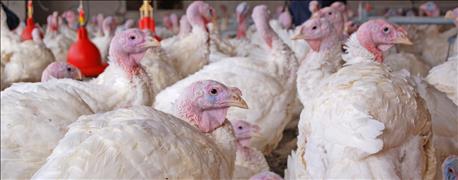
The University of Minnesota Extension and Minnesota Department of Agriculture are asking turkey farmers to complete a brief survey about windbreaks on their farm.
After the highly pathogenic avian influenza (HPAI) outbreak in 2015, some farmers shared anecdotal information about the presence of windbreaks on their farms that may have influenced which barns became infected.
Researchers say the survey should take less than 15 minutes to complete. They would like to hear from all turkey growers — with and without windbreaks — before the end of the year.

BLOWING IN THE WIND: Turkeys are well protected in barns, yet disease may still enter the birds' quarters via the wind.
Funding for the survey is available under the state’s Agricultural Research Education Extension and Technology Transfer grant program. Overall, the grant will be used to examine three areas: what is causing avian influenza, why some fowl are more susceptible, and what prevention measures can be taken. The windbreak survey falls under the third area of this grant’s research.
Sally Noll, U-M Extension poultry specialist, notes that some past research has shown the value of windbreaks on livestock and poultry farms by reducing dust and odor.
“Some studies have indicated that windbreaks can reduce barn-to-barn exposure of poultry respiratory disease, depending on adequacy of the windbreak,” she adds. “During the HPAI outbreak of 2015, one farm noted infection started in barns nearest the gap in their existing windbreak. One observation doesn't make it a fact, but it does raise the question if the windbreak played a role.”
Barn-to-barn transmission of HPAI was found to be an important factor in an outbreak analysis, she says, although the role of wind transmission was not established.
“Windbreaks could play in important role in separating barns and farms from other sources of virus, or in the case of an infected farm, perhaps limiting virus spread during an outbreak,” she says.
That’s why researchers need all turkey farmers to participate and take the windbreak survey. The survey includes questions on turkey farm size and number of barns, barn locations, number of turkeys in brooder barns and grower/finisher barns, windbreak location and type of windbreak.
“The responses to the survey will assist in conducting research with producers regarding their concerns and developing Extension educational materials for those that want more information on windbreaks and vegetative buffers,” Noll adds.
After collecting the windbreak data, Extension also would like to identify farms that would be willing to collaborate on collecting additional information, such as presence of wildlife and wild birds that may be associated with the windbreak or farm.
The sooner turkey farmers complete the survey, the more helpful it will be for researchers to be able to move onto the other two areas to study using the grant. Researchers would prefer to hear from farmers well before the Dec. 31 deadline.
To receive a link to take the survey online, turkey farmers are asked to email Gary Wyatt, Extension educator, at [email protected].
About the Author(s)
You May Also Like






